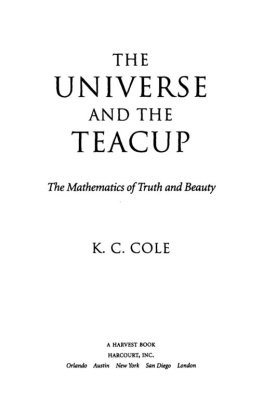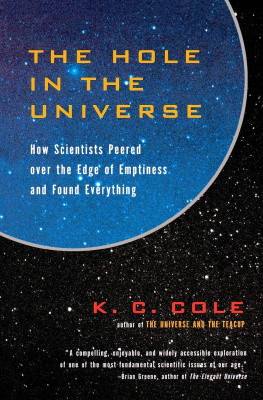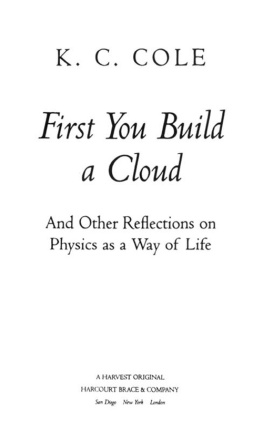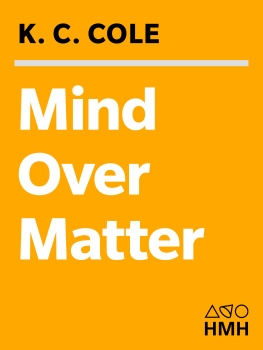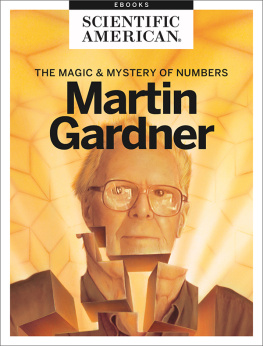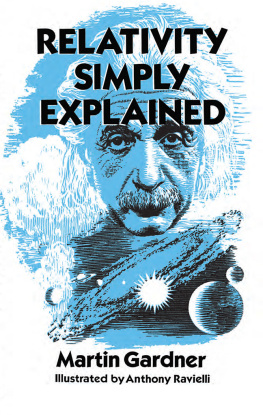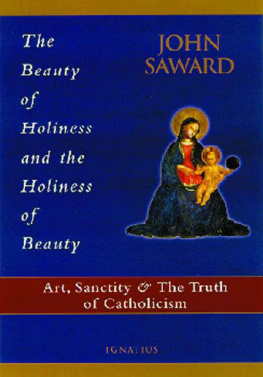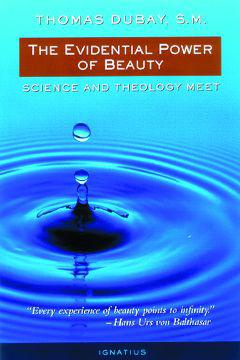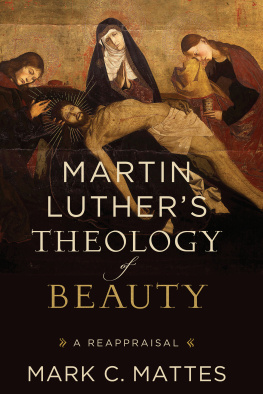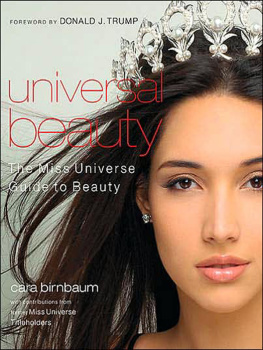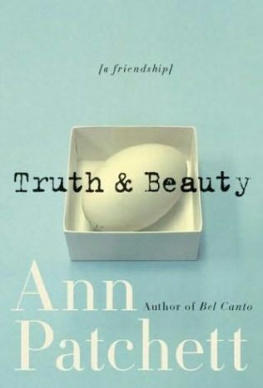K. C. Cole - The Universe and the Teacup: The Mathematics of Truth and Beauty
Here you can read online K. C. Cole - The Universe and the Teacup: The Mathematics of Truth and Beauty full text of the book (entire story) in english for free. Download pdf and epub, get meaning, cover and reviews about this ebook. year: 1998, publisher: Houghton Mifflin Harcourt, genre: Science. Description of the work, (preface) as well as reviews are available. Best literature library LitArk.com created for fans of good reading and offers a wide selection of genres:
Romance novel
Science fiction
Adventure
Detective
Science
History
Home and family
Prose
Art
Politics
Computer
Non-fiction
Religion
Business
Children
Humor
Choose a favorite category and find really read worthwhile books. Enjoy immersion in the world of imagination, feel the emotions of the characters or learn something new for yourself, make an fascinating discovery.
The Universe and the Teacup: The Mathematics of Truth and Beauty: summary, description and annotation
We offer to read an annotation, description, summary or preface (depends on what the author of the book "The Universe and the Teacup: The Mathematics of Truth and Beauty" wrote himself). If you haven't found the necessary information about the book — write in the comments, we will try to find it.
K. C. Cole: author's other books
Who wrote The Universe and the Teacup: The Mathematics of Truth and Beauty? Find out the surname, the name of the author of the book and a list of all author's works by series.
The Universe and the Teacup: The Mathematics of Truth and Beauty — read online for free the complete book (whole text) full work
Below is the text of the book, divided by pages. System saving the place of the last page read, allows you to conveniently read the book "The Universe and the Teacup: The Mathematics of Truth and Beauty" online for free, without having to search again every time where you left off. Put a bookmark, and you can go to the page where you finished reading at any time.
Font size:
Interval:
Bookmark:
Also by K.C. Cole
FIRST YOU BUILD A CLOUD
Copyright 1997 by K. C. Cole
All rights reserved. No part of this publication may be reproduced or transmitted in any form or by any means, electronic or mechanical, including photocopy, recording, or any information storage and retrieval system, without permission in writing from the publisher.
Requests for permission to make copies of any part of the work should be submitted online at www.harcourt.com/contact or mailed to the following address: Permissions Department, Harcourt, Inc., 6277 Sea Harbor Drive, Orlando, Florida 32887-6777.
www.HarcourtBooks.com
Library of Congress Cataloging-in-Publication Data
Cole, K. C.
The universe and the teacup:
The mathematics of truth and beauty/K. C. Cole.1st ed.
p. cm.
Includes bibliographic references and index.
ISBN 978-0-15-100323-5
ISBN 978-0-15-600656-9 (pbk.)
1. Mathematics. 2. Truth (Aesthetics).
3. Aesthetics. I. Title
QA36.C65 1998
510dc21 97-22338
Text set in Minion
Designed by Kaelin Chappell
First Harvest edition 1999
DOC 10 9 8 7 6
For Frank
Ultimately, the credit for this book has to go to my editor, Jane Isay, who first told me it was a math book. Initially, that came as a complete surprise. Id come in to talk with her about a bunch of ideas Id been tossing around for years, inspired by a great number of friends, colleagues, authors of books and essays whom Id never met, and scientists Id talked with only on the phone. Yet somehow, I didnt have the perspective to see that the one common thread tying it all together was mathematics. Thank you, Jane.
The other influences encompass almost everyone who ever had an impact on me, so I wont even try to be inclusive. However, a great number can be found listed in the bibliography at the end of this book; a great many others are the scientists and mathematicians who are represented in the text only by an odd quote here and there but whose advice and ideas permeate the whole. Thank you, all, for all those hours of conversations, questions, requests. A special thank you also to Cathleen Morawetz, who carefully went through an early outline of this book (before I knew it was about the mathematics of truth) and offered caveats and encouragement I took very much to heart.
I am most grateful to those who read the entire manuscript for me, in various drafts, offering advice, insights, additions and sometimes simply saving me from stupid mistakes. Thank you: Virginia Barber, Keith Devlin, David Goodstein, Haim Harrari, Roald Hoffmann, Gerald Holton, Tom Humphrey, Patty OToole. Thank you, also, to those who rendered the same indispensable service on portions of the book: Susan Chace, Elsa Feher, Adam Frank, Liz Janssen, and Lawrence Krauss. Obviously, whatever stupid mistakes remain are mine.
My editor at the Los Angeles Times, Joel Greenberg, helped hone and challenge my ideas as subjects I was exploring for the book inevitably seeped into articles I then wrote for the paper (and eventually, vice versa). Thank you, Joel.
I couldnt have written the book without the continual support of my friendsespecially Mary Kay Blakely, Susan Chace, Evelyn Renold, Patty OToole, Claudette Sutherland, and Mary Lou Weis-man. Thanks to my children, Pete and Liz Janssen, for enriching my life in myriad ways and making me wiser. And a huge thank you to my father, Bob Cole, for always being there.
Id also like to mention the indirect but important inspiration I received from two writers organizations Im proud to be part of: PEN Center West, for reminding me that writers throughout the world pay dearly (sometimes with their lives) for a career I take for granted, and the women of JAWS, for high standards and courage.
Finally, thanks to my agent, Ginger Barber, not only for her thorough and useful commentary but also for setting up that conversation with Jane Isay.
At the fundamental level nature, for whatever reason, prefers beauty.
physicist David Gross, director of the Institute for Theoretical Physics at University of California, Santa Barbara
Mathematics seems to have astonishing power to tell us how things work, why things are the way they are, and what the universe would tell us if we could only learn to listen. This comes as a surprise from a branch of human activity that is supposed to be abstract, objective, and devoid of sentiment.
Yet, the way we view ourselves is closely connected to what we know (or think we know) about objective aspects of nature. Math tells us truths not only about how gravity works (the better to build bridges), but also universal truths that influence how we think and feel (the better to build societies). Physicist Frank Oppenheimer liked to call these the sentimental fruits of science.
True, math does all the things we learned in school: building bridges and balancing checkbooks and calculating the odds of winning the lottery. But it also sheds light on those muddles of the mind that keep not only scientists up at night, but also artists and actors and poets and schoolteachers and psychologists and lovers and parents: How can we make sense of nature, including human nature? What is the nature of truth?
People search for the answers in God and in equations (sometimes both at the same time), by writing plays and studying ants. Curiously, the same methods of thinking that helped reveal light as an undulating electromagnetic field can also help sort out the causes of various social problems. The same approaches to proof that physicists used to establish the reality of a particle called the top quark are brought to the courtroom in the trial of O.J. Simpson.
Its a heady notion: Mathematicsthat seemingly dry stuffhas so much relevance to the deep philosophical ideas that are the foundations of society. By learning how it works, we can get a better grip on everything from obscure aspects of physics to methods of fashioning fairer divorce settlements.
Thats one reason Ive tried in this book to directly relate ideas from mathematics to problem solving in unlikely placesfrom life on Mars to the riddle of the Unabomber. Its an attempt to demonstrate how mathematics informs the kinds of questions people really think and worry about. If I could accomplish one thing in this book, it would be to show that an interest in the quality of life is in no way diminished by quantitative arguments. Quantity and quality are inseparable. Scientists and mathematicians, as well as saints and philosophers, search for the fundamental hows and whys of existence. And although they have different standards of evidence and proof, quantitative insights do help us understand qualitative problems.
Of course, mathematical tools do not substitute for the insights of artists and actors and economists and psychologists and historians and writers and spiritual leaders. But they can supply badly needed fresh perspectives.
This book is structured in five (not equal) parts. In the introductory chapter (Whats Math Got to Do with It?), I present the idea that mathematics is not about numbers so much as it is a way of thinking, a way of framing questions that allows us to turn things inside out and upside down to get a better sense of their true nature. Mathematicians know this, of course, but most people outside the profession do not. The chapter tours some of the unexpected territory covered by mathematicsfrom daily headlines to the Golden Rule.
The first section (Where Mind Meets Math) demonstrates some of the reasons we need math to help sift through the confusion. In the first place, numbers dont speak for themselves, because our all too human brains get in the way. Certain kinds of relationships that ought to be plain to everyone simply cant penetrate the veil that physiology and experience puts between knowledge and truth. Indeed, these mental filters make it difficult (perhaps impossible) for human brains to perceive things the way they really are (whatever that is). They are necessary parts of human psychology and physiology, so there is no point trying to cure them. However, it helps a great deal to be aware of themin the same way as it helps if your cars steering pulls to the left, to compensate by pulling to the right.
Next pageFont size:
Interval:
Bookmark:
Similar books «The Universe and the Teacup: The Mathematics of Truth and Beauty»
Look at similar books to The Universe and the Teacup: The Mathematics of Truth and Beauty. We have selected literature similar in name and meaning in the hope of providing readers with more options to find new, interesting, not yet read works.
Discussion, reviews of the book The Universe and the Teacup: The Mathematics of Truth and Beauty and just readers' own opinions. Leave your comments, write what you think about the work, its meaning or the main characters. Specify what exactly you liked and what you didn't like, and why you think so.

